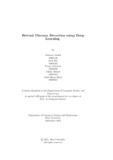| dc.contributor.advisor | Karim, Dewan Ziaul | |
| dc.contributor.author | Mashfi, Shahriar | |
| dc.contributor.author | Roy, Amit | |
| dc.contributor.author | Abdullah, Riasat | |
| dc.contributor.author | Ahmed, Fahim | |
| dc.contributor.author | Khan, Sazid Hayat | |
| dc.date.accessioned | 2023-02-26T06:09:36Z | |
| dc.date.available | 2023-02-26T06:09:36Z | |
| dc.date.copyright | 2022 | |
| dc.date.issued | 2022-09 | |
| dc.identifier.other | ID: 18201126 | |
| dc.identifier.other | ID: 18301261 | |
| dc.identifier.other | ID: 21101339 | |
| dc.identifier.other | ID: 20301485 | |
| dc.identifier.other | ID: 18201015 | |
| dc.identifier.uri | http://hdl.handle.net/10361/17919 | |
| dc.description | This thesis is submitted in partial fulfillment of the requirements for the degree of Bachelor of Science in Computer Science, 2022. | en_US |
| dc.description | Cataloged from PDF version of thesis. | |
| dc.description | Includes bibliographical references (pages 36-38). | |
| dc.description.abstract | Retina is an important aspect of human vision because it converts light rays into
images and sends messages to the brain. We run the danger of suffering long-term
harm to the eyesight if we have a problem with our retina that might lead to vi sion loss or blindness which can be caused by eye illness, ocular trauma, or other
problems. Retinal based diseases such as diabetic retinopathy, age-related macular
degeneration (AMD) and retinal detachment . However, if someone can take care of
his/her retinal health by eye-checkup annually it might help. Moreover, human civ ilization is now way advanced by the blessings of modern technology. Furthermore,
we came up with an idea which will lead us to the success door of retinal disease
detection in a very easy and cheap way. In this modern world, a large amount of
people use smartphones and high resolution cameras and that is the main fact. De tecting retinal diseases with computer vision based image processing will help a lot
of people in the world to be healthy in terms of their eyesight. We are planning to
apply Convolutional Neural Network (CNN) to identify and classify retinal diseases
with high accuracy. However,we will go through some methodologies such as data
pre-processing, segmentation, analyzing etc. For Large-Scale Image Recognition we
are using our customized Convolutional Network that we have proposed in this pa per. Here, we started our data segmentation from Kaggle. We have used 28972
images from Kaggle as our data-set. Then we segmented it in three parts: Test,
training and validation. And here we will detect a total of four different retinal
pictures.. They are: CNV, DME, DRUSEN and NORMAL. We have trained our
proposed CNN model with these dataset and gained 98.97% validation accuracy.
Moreover, we also run some pre-trained models. They are: Resnet50, Inceptionv3,
EfficientNet B0, Xception and VGG16. We gained 79.34%, 91.32%, 28%, 87.94%
and 94.01% accuracy respectively from them. Hence, we can see that our proposed
CNN model outperformed them in these experimental results. | en_US |
| dc.description.statementofresponsibility | Shahriar Mashfi | |
| dc.description.statementofresponsibility | Amit Roy | |
| dc.description.statementofresponsibility | Riasat Abdullah | |
| dc.description.statementofresponsibility | Fahim Ahmed | |
| dc.description.statementofresponsibility | Sazid Hayat Khan | |
| dc.format.extent | 38 pages | |
| dc.language.iso | en | en_US |
| dc.publisher | Brac University | en_US |
| dc.rights | Brac University theses are protected by copyright. They may be viewed from this source for any purpose, but reproduction or distribution in any format is prohibited without written permission. | |
| dc.subject | Image Processing | en_US |
| dc.subject | Computer vision | en_US |
| dc.subject | CNN | en_US |
| dc.subject | Image Segmentation | en_US |
| dc.subject | CNV | en_US |
| dc.subject | DME | en_US |
| dc.subject | DRUSEN | en_US |
| dc.subject | Resnet50 | en_US |
| dc.subject | Inceptionv3 | en_US |
| dc.subject | EfficientNet B0 | en_US |
| dc.subject | Xception | en_US |
| dc.subject | VGG16 | en_US |
| dc.subject.lcsh | Machine learning--Medical applications. | |
| dc.title | Retinal Diseases Detection using Deep Learning | en_US |
| dc.type | Thesis | en_US |
| dc.contributor.department | Department of Computer Science and Engineering, Brac University | |
| dc.description.degree | B. Computer Science | |

